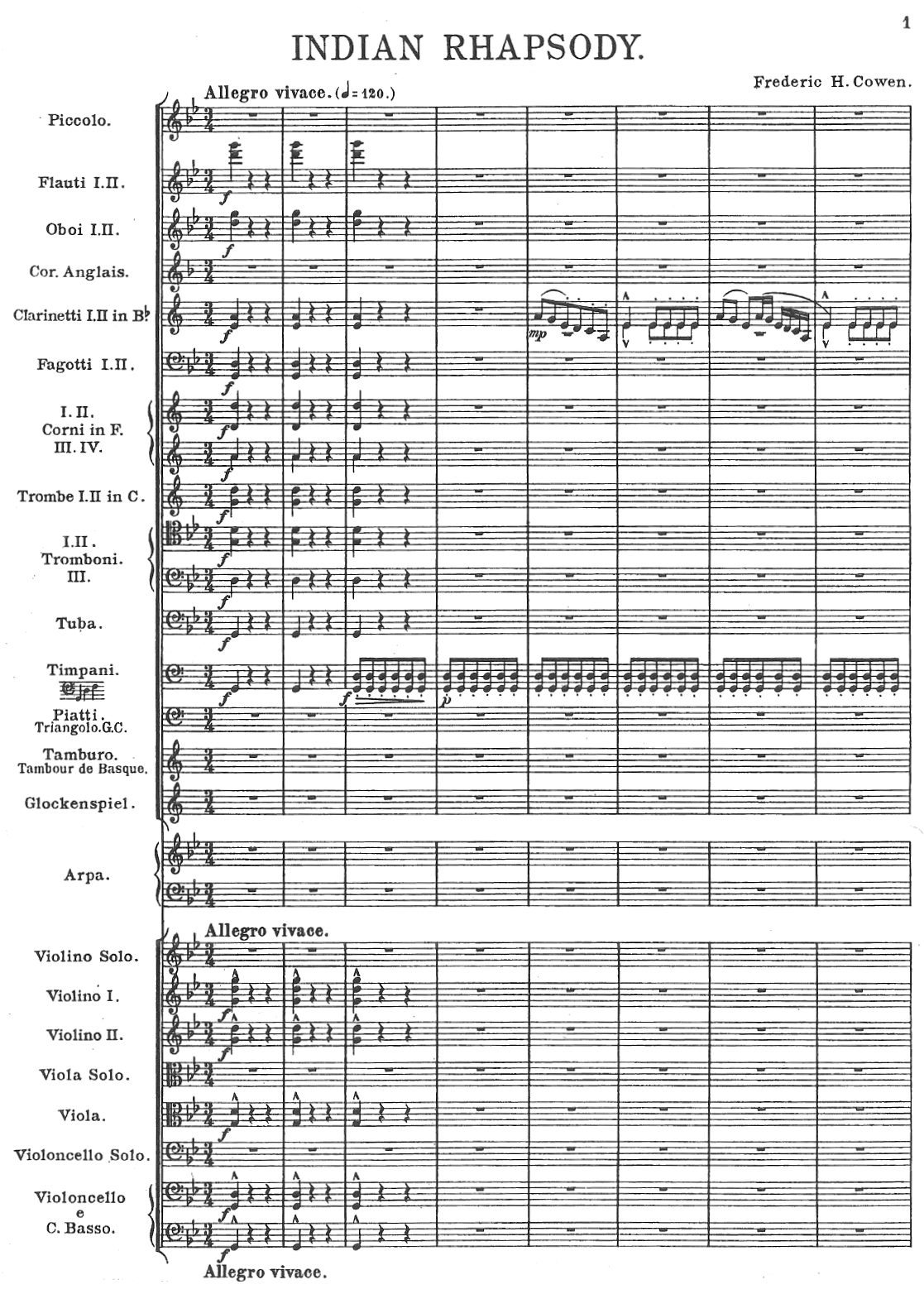

Frederic Hymen Cowen
(b. Kingston, Jamaica, 29 January 1852; d. 6 October 1935, London)
Indian Rhapsody
Frederic Cowen was born at Kingston, Jamaica, moving to London when his father became treasurer of Her Majesty’s Opera and subsequently of the Theatre Royal, Drury Lane. Frederic showed an early aptitude for music, being encouraged by Sir Henry Bishop, taking lessons with John Goss and Julius Benedict, before eventually studying at Leipzig and Berlin with Ignaz Moscheles, Carl Reinecke, Louis Plaidy and Friedrich Kiel. His career was to be mainly as a conductor, notably of the Royal Philharmonic Society, the Halle, Liverpool Philharmonic and Scottish orchestras, and of the Handel Triennial Festival. It was through his conducting that Cowen became acquainted with Liszt, Rubinstein, Brahms, Grieg, Dvořák and many other contemporary musicians.
As a composer, he achieved most success with his songs (more than 300 of them) and choral works, but he regarded his six symphonies as the pinnacle of his output. The Third Symphony (“The Scandanavian”) was his most successful (MPH score 749) and all six show a comfort with large structures, as well as a genuine flair for orchestration. That said, none could be said to be ‘forward looking’, and each is a good example of a post-Mendelssohn, post-Schumann European symphony.
The Indian Rhapsody dates from 1903 and was written for the Scottish Orchestra (now the Royal Scottish National Orchestra) of which he had become the conductor in 1900. It was first performed at the Three Choirs Festival in the year of its composition.
The use of “Indian” may lead us astray, because this has nothing to do with India. These are Native Americans, and this is one of the many exotic pieces written in the wake of Dvorak’s New World Symphony and Coleridge Taylor’s Hiawatha’s Wedding Feast. The whole is a 15-minute piece of colourful exotica, pre-dating the conventions of Hollywood westerns by several years, and demonstrating Cowen’s ear for orchestral effect as he incorporates several genuine Native American themes.
Phillip Brookes, 2013
Frederic Hymen Cowen
(geb. Kingston, Jamaika, 29. Januar 1852 - gest. London, 6. Oktober 1935)
Indian Rhapsody
Frederic Cowen, geboren in Kingston/Jamaika, siedelte nach London um, als sein Vater Schatzmeister von Her Majesty’s Opera und anschliessend auch des Theatre Royal, Drury Lane wurde. Früh als musikalische begabt erkannt, und ermutigt durch Sir Henry Bishop nahm er Unterricht bei John Goss und Julius Benedict, bevor er schliesslich in Leipzig und Berlin bei Ignaz Moscheles, Carl Reinecke, Louis Plaidy und Friedrich Kiel studierte. Seine berufliche Karriere machte er hauptsächlich als Dirigent, vor allem bei der Royal Philharmonic Society, the Halle, den Liverpool Philharmonic, schottischen Orchestern und dem Handel Triennial Festival. Durch diese Tätigkeit machte er die Bekanntschaft von vielen zeitgenössischen Musikern, darunter Liszt, Rubinstein, Brahms, Grieg und Dvořák.
Als Komponist hatte Cowen mit Liedern (er schrieb mehr als 300) und Chorwerken den grössten Erfolg, aber seine sechs Symphonien hielt er für die Krönung seines Werks. Die Dritte Symphonie (“The Scandinavian”) war seine erfolgreichste Komposition in dieser Gattung (mph 749), alle seine Symphonien zeigen einen vertrauten Umgang mit grossen Formen und eine individuelle Note bei der Orchestration. Abgesehen davon kann man Cowen nicht als vorwärtsweisenden Komponisten bezeichnen, jedes dieser Werke ist ein gutes Beispiel für eine europäische Symphonie aus der Ära zwischen Mendelssohn und Schumann.
Die Indian Rhapsody entstand 1903 und wurde für das Scottish Orchestra (heute das Royal Scottish National Orchestra) geschrieben, dessen Dirigent er 1900 wurde. Uraufgeführt wurde sie im Jahr ihres Entstehens anlässlich des Three Choirs Festivals.
Der Begriff “Indian” ist irreführend, denn das Werk hat mit Indien nichts zu tun. Gemeint sind vielmehr nordamerikanische Indianer, und es handelt sich hier um eines der zahlreichen exotischen Stücke, die im Umfeld von Dvoraks “Neue Welt” - Symphonie und Coleridge Taylor’s Hiawatha’s Wedding Feast entstanden. Mit 15 Minuten Spieldauer ist das Werk ein Stück voller farbenprächtiger Exotika, es weist um viele Jahre auf die Klischees des Hollywood - Westerns voraus und zeigt Cowens besonderes Talent für orchestrale Effekte, wenn er musikalische Themen der amerikanischen Ureinwohner in die Musik integriert.
Phillip Brookes, 2013
Wegen Aufführungsmaterial wenden Sie sich bitte an Boosey & Hawkes, Berlin. Nachdruck einer Partitur aus der Sammlung Phillip Brookes, Roxas City.